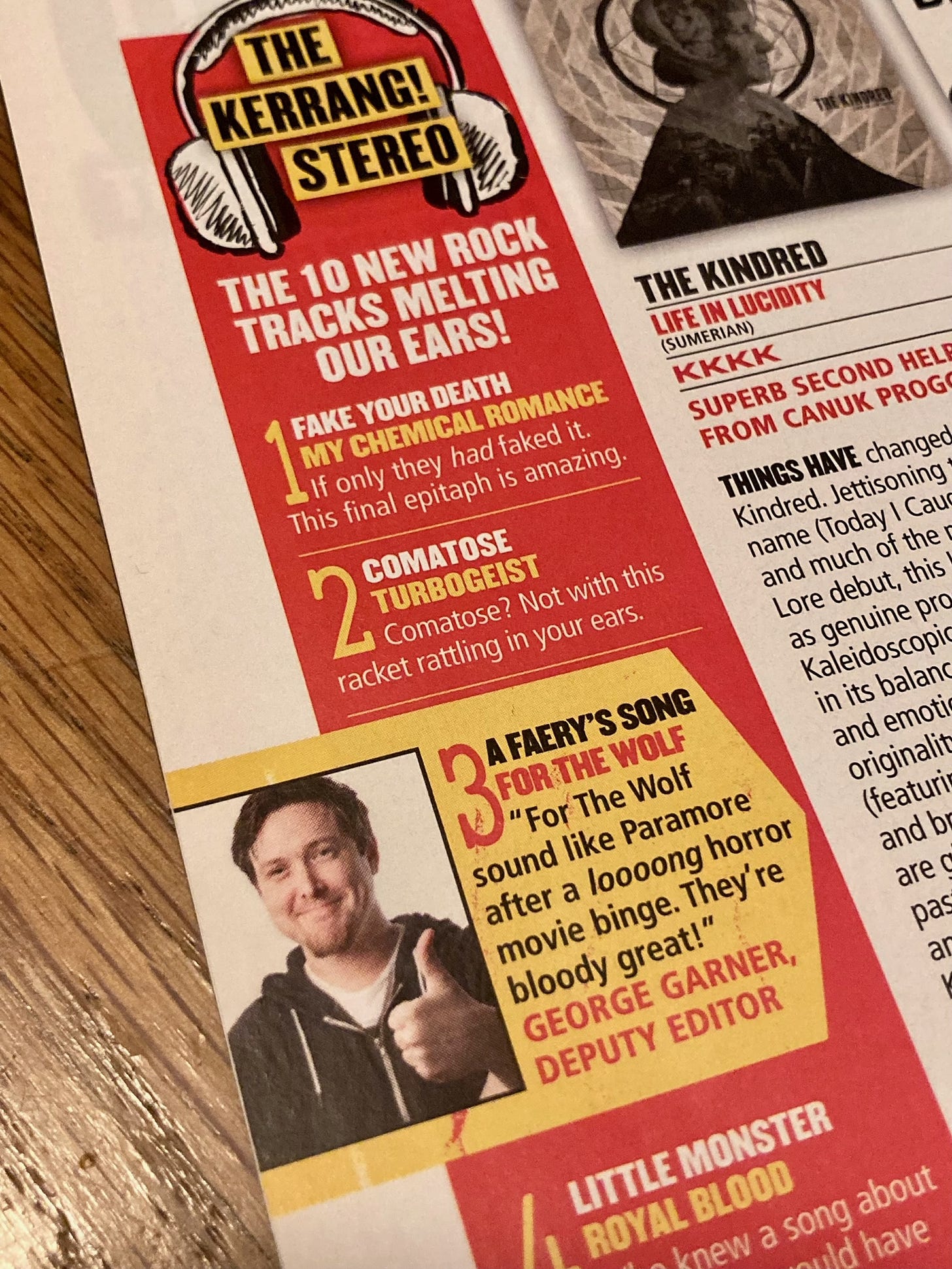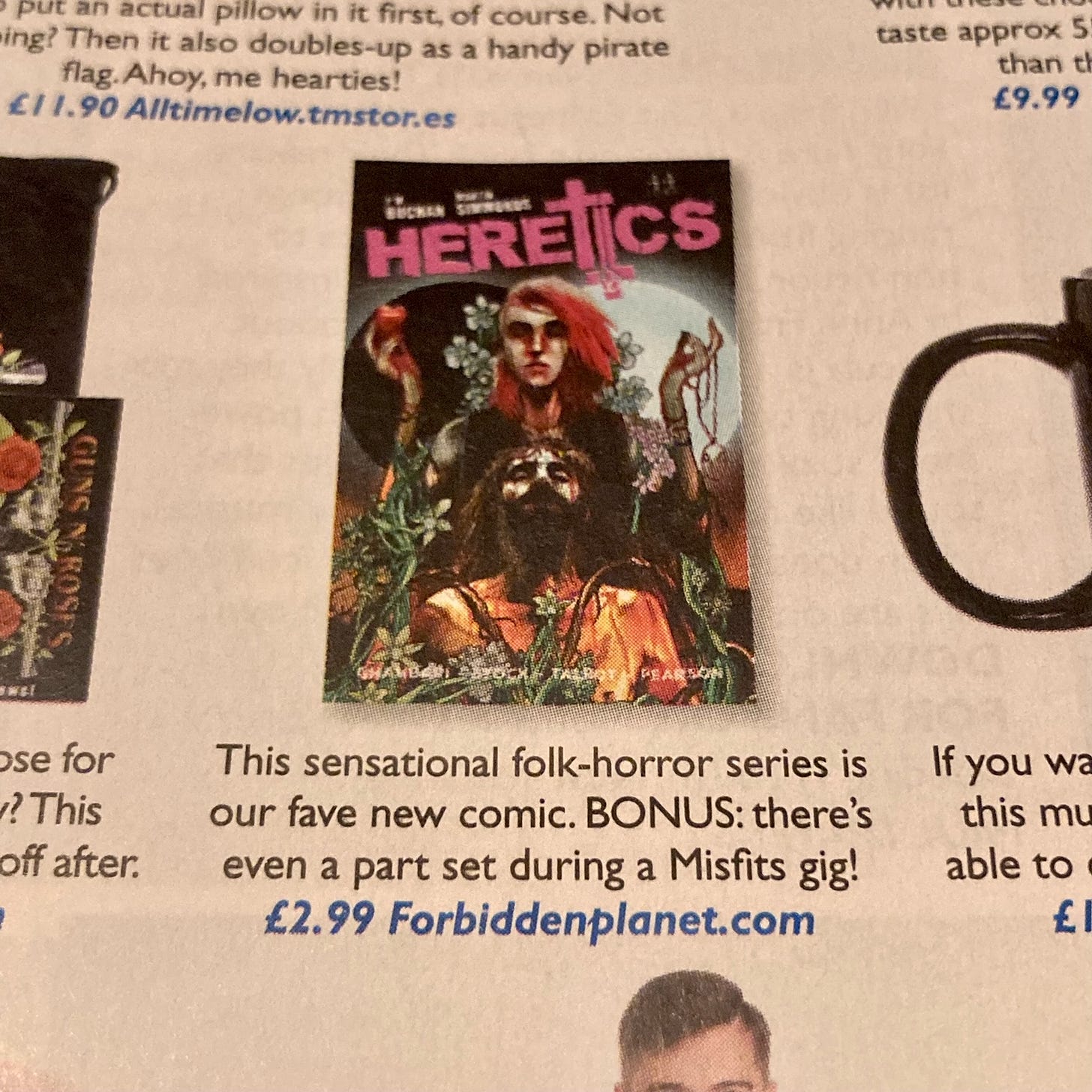An interview with Sam L Barker from Be My Escape
Journeys into pop & emo 1999-2009 + the enduring appeal of Kerrang!
One of the newsletters that I’ve enjoyed reading the most recently has been Sam L Barker’s Be My Escape, a series of essays and podcasts about pop and emo music from 1999 to 2009. Sam writes with care and passion about a period in alternative music that bumps up against the years when I was most heavily invested in similar bands, essentially detailing the decade that followed and filling in the blanks about what was happening while I was off getting married, starting a family and spending more money on discounted oak flooring and turf than I was on new CDs.
Today I’m interviewing Sam about his motivations as a writer and why he feels like music played such a vital role for so many of us when we were growing up. One of the areas where our interests intersect is our love of the British magazine of rock, punk and heavy metal, Kerrang! After the interview I delve into my longstanding love for the magazine and the role that it has played in my own life.
An interview with Sam L Barker
Can you please introduce yourself and explain how you started writing Be My Escape?
Sure thing. My name’s Sam Barker, I’m a freelance writer on a number of music and culture topics. But my specific interest is on emo and pop punk albums from roughly 1999-2009 or so. I’m currently writing an essay series called Be My Escape where I look into the background of some of the albums that I consider the most important, or mean the most to me from that era, and talk about why they’re so vital. So for instance looking at My Chemical Romance’s Three Cheers for Sweet Revenge and how it encapsulates post-9/11 paranoia, Pete Wentz of Fall Out Boy’s novel and quite beautiful use of blogging to connect with his fans, or Paramore’s Riot from the perspective of Hayley Williams as a barrier-breaking women in pop punk. I want to look at why these albums, and artists, are so timeless and why they’re still so beloved to this day: by myself of course, but also by millions of others all over the world.
Why do you think that music played such a formative role for us growing up and do you think that music means the same in 2024 as it did in previous decades?
When you’re growing up, you’re interfacing with the world in a very wide-eyed way. Think about the transition from someone being 11 to 12 to 13. You don’t have much of a cultural frame of reference, you’re still a baby, so if a song comes along like Welcome to the Jungle, Juicy or Champagne Supernova, it’s dunking you into this entire shocking world you never knew existed before- song, hook, icon, image, history. They have everything. It’s an invitation to another world, the type of which you only get a few times in your life. And that massive shift becomes the building blocks of your new teenage identity- as someone who, at 13 or 14, doesn’t have much to show for themselves, so the things you like become who you are. That’s definitely how it felt for me when I first heard American Idiot and I never looked back.
I think it is actually roughly the same for modern teenagers as it’s always been. Still discovering these songs and making them who they are. The big difference now is that the internet has totally swamped culture, and made everything one teeming mass of content. Back 20 years ago you had separate magazines, radio stations, websites. But in Web 3.0 teenagers today don’t have to pick and choose their identity in that exclusive way. All music is free and so is opinion. Being omnivorous is considered a virtue, so there’s no contradiction being into Punk, Hip Hop, Chart Pop, IDM and Extreme Metal all at once. In fact it’s considered a good, broad minded thing- and it is. Even the fashion is all mixed and matched up. But that freedom also makes it harder to create a distinct identity, to kick back against the world and find solace in a specific “tribe”. In order to create a subculture you have to gatekeep to some degree, it’s something that’s always sucked but is also part of making any kind of delineation. Now that’s gone, mostly for better, but I think we’re still grappling with the affects.
How did you discover the bands that you write about in Be My Escape?
I used to read the UK alternative music magazine Kerrang! every week from about 2004-2006. It was my absolute lodestar. I was on the internet from around 2004 too, but at that point the content available for alt, pop punk, emo, metal fans etc was either too rudimentary, or too obscure for a young teenager like me to navigate. So I was very much using old school journalism and opinion to help guide me, alongside some help from burgeoning social media sites like MySpace and Bebo. Most of the bands I’m writing about came to me that way, but a chunk of them also came from when streaming became a thing and I first started using YouTube around 2007. That then became the primary way I’d find new music, mostly through AMVs (Anime Music Videos) fan made edits combining anime clips and songs. That’s when I started working things out for myself. I found so many bands, and anime, through that way. I discovered New Found Glory’s Dressed to Kill through an Ouran High School Host Club AMV. Again, a deeply formative memory for me.
What is it about emo specifically that appeals and appealed to you?
I often think there’s definitely a parallel universe where instead of Green Day it was Linkin Park that became *my* band and I’m now writing profiles of Korn and Bodycount. Linkin Park were one of those bands big enough that when I started listening to pop radio and music video channels in 2003, I saw them. I always liked them and still respect them immensely, but there was just this immediate connection with Green Day. I liked the fashion sense of Green Day I suppose, but it’s totally irrational. I can’t point to a specific reason I took to pop punk and emo and not nu metal. And that’s kind of the point- we all take our different paths and they’re all valid.
What other kinds of art inspire you?
I’m very much a novice when it comes to film, but my favourite film of all time is Wes Anderson’s Rushmore- which is also massively influential on the image and aesthetics of a whole host of 00s emo and punk bands. (Fall Out Boy, Alkaline Trio, Brand New, My Chemical Romance, the entire Rushmore Records imprint…). That film really moves me in the same kind of youthful naivete, madness and promise that a lot of the music I like has. I think it’s a timeless masterpiece.
But my other area of I suppose great interest is history. Which isn’t art but definitely impacts the way I think about the world. I studied history at university and the more I work on this project the more I understand and see it as a historic exercise. I’m writing my own subculture’s history in many ways: I’m deeply interested in these albums both as artefacts but also living documents.
The writing of yours that I've read to date concentrates on covering the work of other artists - if time, budget and audience were no restraint, what would YOU create and why?
I’ve never actually linked my current writing work to it, so I guess this is a scoop for you. But over lockdown I started writing music with a dear friend of mine under the project name Dead in Shibuya. He sang and we wrote the songs together. It’s a mixture of all the bands we loved growing up, Green Day, My Chemical Romance, Funeral for a Friend, but also classic artists like Queen and David Bowie. So it’s dramatic and theatrical, with a lot of electronic sounds and modern influence too. He loves the Weeknd for instance, which is a great twist to the mix. I’m super proud of it, pouring your heart and soul into something like that is a real privilege.
The enduring appeal of Kerrang!
One of the reasons that Sam’s writing resonates with me is that Kerrang! also played an important role in my life when I was growing up, connecting me to a world that I wanted to join but wasn’t yet a part of.
For overseas readers not familiar with the magazine, Kerrang! is a UK institution for rock, metal and punk music, founded in 1981. For a time it was even the UK’s best-selling weekly music magazine. When I began reading it regularly in the 1990s, Kerrang! was one of the only reliably available windows into a rebellious world of loud music, louder gigs and an adjacent world of alternative culture.
The first copy of Kerrang! that I can remember buying was issue 569, released 28 October 1995, with a free cassette giveaway on the cover of a compilation called RARE (Because Kerrang! Cares). The tape was packed with songs by bands including Silverchair, Carcass, Fear Factory, Machine Head and more, most of which at the time were too heavy for my youthful ears and took some time to adjust to.
Prior to this, the first two albums I bought on cassette were Megadeth’s Countdown to Extinction in 1992 and Meat Loaf’s Bat Out Of Hell II: Back Into Hell in 1993. Clearly it took a few years for me to reach the point where I wanted to walk into a newsagent and spend my own money on music magazines, but I’m pretty sure that by 1995 I was a year or two into secondary school (probably equivalent to starting seventh grade in the US) and had started growing long hair.
This was the period by which Britpop was firmly established in the UK and liking rock or metal music, or being a boy with long hair, marked you out for ridicule and public harassment. We didn’t have the internet at home, or smartphones, and any rock shows on UK radio stations tended to be brief affairs that aired in the dead of night. To find out about new alternative music, I was reliant on copying cassettes from friends, of which I didn’t have many, or buying Kerrang! each week and dreaming about what it would be like to be part of that world.
It was through Kerrang! that I heard about Ozzfest ’98 and petitioned my parents to let me catch a coach to Milton Keynes, 250 miles away, with friends from the year above me in school, at the tender age of 15. The line-up included Black Sabbath, Ozzy Osbourne, Foo Fighters, Pantera, Slayer, and one of the most underrated bands of all time, Human Waste Project.
Within two weeks of returning home from Ozzfest I caught a bus into Newcastle city centre to watch a mini festival of local bands, passing for 18, drinking alcohol for the first time and making friends with a gaggle of miscreant punks and troublemakers. I’d never had friends outside of school, until that summer, and it changed the trajectory of my life completely.
I bought and read Kerrang! religiously between 1995 and 1999, a period when the vast majority of British rock and metal bands were overshadowed either by the nation’s fascination with Britpop or the US-driven emergence of nu metal. By the end of the 20th century I began gravitating more towards punk-rock and ska, listening first to Famous Monsters by Misfits on repeat, and later to Sublime, Save Ferris, Reel Big Fish and pretty much any band that would fit on a Vans Warped Tour.
I had moved out of home, joined university and moved on before Sam Barker’s formative Kerrang! days, which makes reading his newsletter and finding out more about all the bands I was too busy drinking to pay attention to such a joy.
Years later, Kerrang! would orbit into my life again thanks to a comic-book artist who I collaborated with frequently. Phillip Marsden, who I spent a few years working with in a comic shop (and who took glee in berating me for my long hair, a memory that I cherish with irony since he grew his own luscious locks), was the first artist to illustrate one of my scripts, and together with Jack Fallows we created the BLACKOUT anthology. There were originally four black-and-white issues of BLACKOUT, published between around 2004 and 2008, before we progressed to full colour and invited additional contributors for BLACKOUT (2012) and BLACKOUT II: YOLO (2013).
That decade, Phillip Marsden became a regular illustrator for Kerrang! magazine, and I was able to pitch our comics by stating that I had written for a frequent Kerrang! flyer. The first time that one of my own creative projects featured in Kerrang! came in a roundabout way. My friend Joe Whiteford introduced me to an Oklahoma-based band called For the Wolf (now Labadie House) after he created an illustration for one of their Kickstarters.
Chatting to the band, we hit it off, and I shared the first issue of my comic-book series LA BELLE DAME SANS MERCI with them. Not long passed before For the Wolf had written a track based on LBDSM, recorded a music video to accompany it, and included the song on Turn On the Dark, their first album with Horrorhound records.
I submitted the track to Kerrang! and the next week it was featured in The Kerrang! Stereo section of issue 1506, 1 March 2014. A song based on one of my comics! A few years later when the zero issue of our series HERETICS was released and was featured in issue 1644, 5 November 2016, that felt like an even bigger achievement.
Not long after that, Kerrang! interviewed me and HERETICS co-creator Martin Simmonds, and I achieved my lifelong dream of being featured in the magazine that had played such a massive part in my formative years.
The idea of Kerrang! has had to change to survive in the 2020s, but they’re still the leading light in journalism when it comes to UK rock, punk and metal.
You might also enjoy
An interview with Dan Franklin
An interview with Dan Franklin, author of COME MY FANATICS: A JOURNEY INTO THE WORLD OF ELECTRIC WIZARD and HEAVY: HOW METAL CHANGES THE WAY WE SEE THE WORLD. Originally published 18 April 2020. Look for reviews of Dan's books in Kerrang!, obvs.
Coming up next week: an interview with writer John Harris Dunning, whose comic-book series Summer Shadows (with Ricardo Cabral) and Ripperland (with Steve Orlando and Alessandro Oliveri) are both currently being published by Dark Horse Comics.
In 2014 he instigated and co-curated the Comics Unmasked: Art and Anarchy in the UK exhibition at the British Library, the largest and most prestigious exhibition of comics in the UK to date. As a journalist he’s contributed to The Guardian, Metro, GQ, Esquire, Dazed and iD.










Thanks again, I really enjoyed doing this :D